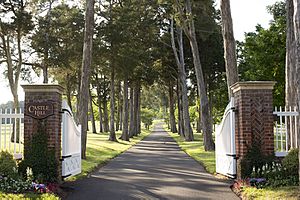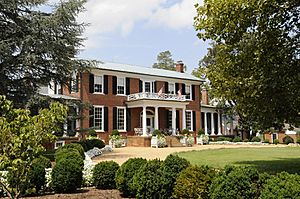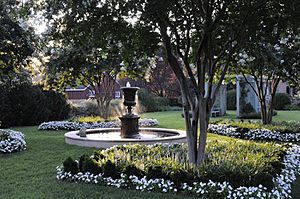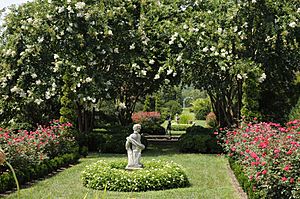Castle Hill (Virginia) facts for kids
|
Castle Hill
|
|
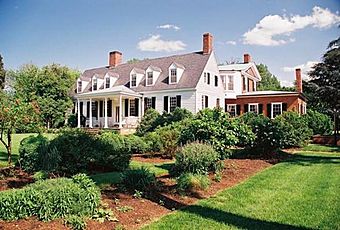
Castle Hill mansion and grounds
|
|
| Location | Northeast of Cismont near the junction of VA 231 and VA 640, near Charlottesville, Virginia |
|---|---|
| Built | 1764/1824 |
| Architect | Thomas Walker & Captain John Perry |
| Architectural style | Colonial and Federal |
| NRHP reference No. | 72001379 |
Quick facts for kids Significant dates |
|
| Added to NRHP | February 23, 1972 |
Castle Hill (Virginia) is a very old, large home and property in Virginia. It covers about 600 acres (243 hectares) and is privately owned. You can find it at the base of the Southwest Mountains in Albemarle County. It's close to Monticello and the city of Charlottesville.
Castle Hill is important because it's listed on the Virginia Landmarks Register and the National Register of Historic Places. It was the cherished home of Dr. Thomas Walker (1715–1794) and his wife, Mildred Thornton Meriwether. Dr. Walker was a good friend and doctor to Peter Jefferson. After Peter Jefferson died, Dr. Walker became the guardian of young Thomas Jefferson.
The Story of Castle Hill
How Castle Hill Began
Dr. Thomas Walker got the land for Castle Hill in 1741. He received it through his marriage to Mildred Meriwether. The property was huge, about 15,000 acres! Young Thomas Jefferson, who loved music, used to play his violin in the main hall. Even younger James Madison would dance there.
A Brave Act in History
In 1781, something very important happened at Castle Hill. Dr. Walker's wife, Mildred, bravely delayed a British officer named Banastre Tarleton. This gave Jack Jouett enough time to warn Governor Thomas Jefferson. He also warned the Virginia lawmakers. Tarleton had planned to capture them, but Mildred's quick thinking saved the day!
Famous Visitors to Castle Hill
Many important people visited Castle Hill over the years. Besides Thomas Jefferson, several U.S. Presidents stayed there. These included George Washington, James Madison, James Monroe, Andrew Jackson, James Buchanan, Martin Van Buren, and John Tyler. Other famous figures like Patrick Henry, Robert E. Lee, Henry Clay, and Daniel Webster also visited.
The Rives Family and Castle Hill
Dr. Thomas Walker's youngest son, Francis Walker, inherited Castle Hill. He married Jane Byrd Nelson, whose father was Governor Thomas Nelson. Later, Thomas and Mildred Walker's granddaughter, Judith Page Walker, inherited the estate. She married U.S. Senator William Cabell Rives.
William Cabell Rives studied law with Thomas Jefferson at Monticello. He was also a friend of James Madison. At Castle Hill, Rives wrote a three-book biography about Madison. Judith Rives was a close friend of Dolley Madison. She wrote a novel called Home and the World. In her book, she described life at Castle Hill as a made-up place called “Avonmore.”
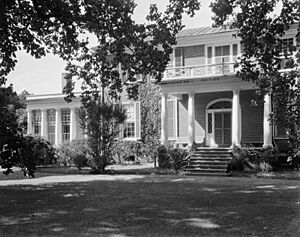
Castle Hill in the 20th Century
Colonel Alfred Landon Rives, the son of William and Judith Rives, inherited Castle Hill next. He was a chief engineer for General Robert E. Lee during the American Civil War. After he and his wife passed away, their daughter, Amélie Louise Rives Troubetzkoy, inherited the property.
Amélie was a famous writer and an early supporter of women's rights. She was married to Russian Prince Pierre Troubetzkoy, an artist. Amélie wrote several novels inspired by her life at Castle Hill. These included Virginia of Virginia and The Quick or the Dead?. Castle Hill and Amélie were even featured in a New York Times article in 1906.
In the early 1900s, Amélie's sister, Mrs. Gertrude Rives Potts, managed the estate. She became known as the first woman Master of Foxhounds. Gertrude brought English Foxhounds to Castle Hill. She trained them and her own horses. She also created a hunting staff and got permission from neighbors to use their land for hunting. Castle Hill later became part of the Keswick Hunt Club.
Castle Hill's Design
The Original House
The first part of Castle Hill was built by Dr. Walker in 1764. It was a colonial-style house made of wood, with a front porch facing west. It had six dormer windows, which are windows that stick out from the roof.
Later Additions
In 1824, William and Judith Rives added a new section to the house. This part was made of brick in the Federal style. It was built by Captain John Perry, who was one of Thomas Jefferson's main bricklayers. Later, in 1844, more additions were made. Columned conservatories, which are like glass rooms, were added to each end of Perry's section. Another bricklayer who worked for Jefferson, William B. Phillips, built these.
Beautiful Gardens
Castle Hill is also famous for its beautiful formal gardens. Gertrude Potts wrote about them in a book called Historic Gardens of Virginia. The very tall box-hedges at the top of the gardens are some of the most impressive in Virginia. In 1997, a Landscape architect named Rachel M. Lily designed the current, larger gardens. They have many levels and a balanced, formal look.
Castle Hill Today
Today, Castle Hill is still a private home.



